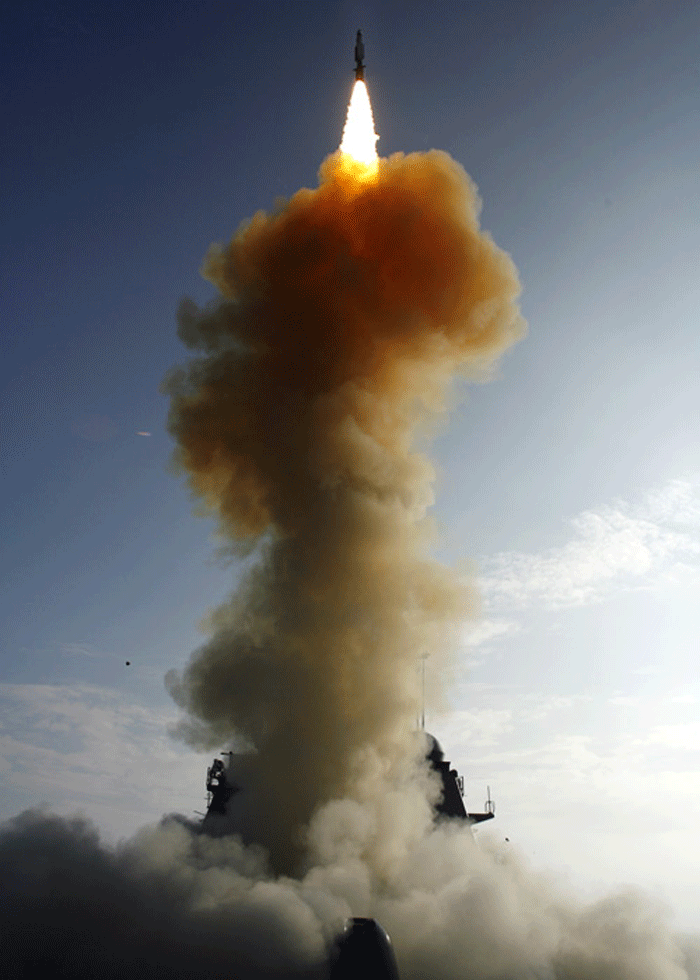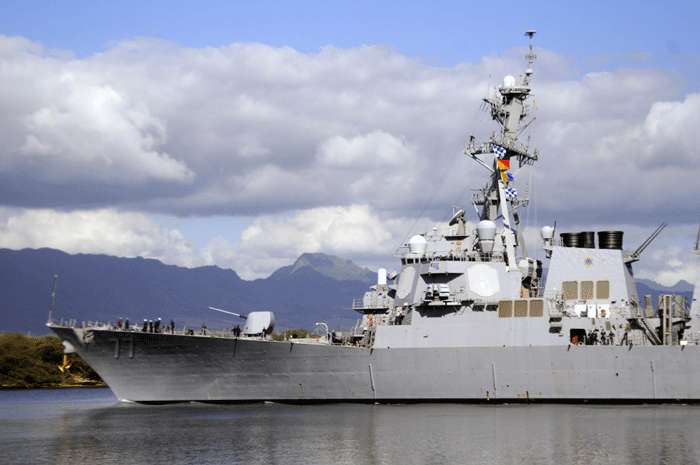
Photo Credit: SM3 Missile Launch, http://news.cnet.com
03/10/2011 – The Obama Administration has placed significant emphasis on continuing the upgrade path for the Aegis BMD program. By cancelling the Bush missile defense program in Europe, de facto, the Administration highlighted its commitment to Aegis as a key element for global missile defense. But the evolution of the program depends upon a continuing significant commitment of increasingly scarce resources to testing and using test results to shape the concurrent development and manufacturing program. And as the F-35 Joint Strike Fighter comes on line, the integration of Aegis with F-35 will provide a powerful capability for the US and its allies. It must always be remembered how significant numbers of allied partners are in the Aegis deployed fleet, and that there are several joint Aegis and F-35 allies in prospect.
![10P00296_054[1]](https://www.sldinfo.com/wp-content/uploads/2011/03/10P00296_0541.gif)
Photo Credit: F-35C in Flight, Credit, Lockheed Martin
The Missile Defense Agency (MDA) plans to conduct several ballistic missile defense flight tests during the remainder of fiscal year 2011.In April, the MDA will conduct its first “launch-on-remote” test of the Aegis BMD system against a “separating target,” i.e., a warhead separating from its booster missile. The Flight Test Maritime (FTM) 15 event will consist of an Aegis BMD-equipped ship firing a Standard Missile-3 Block IA missile in response to remote sensor data provided by a forward-based AN/TPY-2 radar. During the third quarter of fiscal year 2011, MDA plans to conduct Aegis BMD FTM-16, the first intercept test of the SM-3 Block IB missile.Later in the summer, MDA plans to conduct a test of the Terminal High-Altitude Area Defense (THAAD) system in which two THAAD interceptors will attempt to engage two short-range ballistic missile targets. Similar to the successful two-shot salvo test by a single Aegis BMD ship against two ballistic missiles in 2007, this 2011 THAAD test will mark the first time the ground-based system is engaged in a multiple intercept scenario.
Finally, MDA also plans to hold a test involving the U.S. and Japanese navies where the Aegis BMD 4.0.1 software system conduct a “simulated intercept” of various medium-range ballistic missile targets.The FTM-15 event will be a test that features a “straight-stick” ABMD system installed on board the guided-missile destroyer USS O’Kane (DDG 77) and pits for the first time an in-service SM-3 Block 1A missile against a modified intermediate-range Trident I/C-4 ballistic missile target, called the “LV-2.” Although this is the first ABMD/SM-3 attempt to intercept this type target, the LV-2 has flown in previous BMD live-fire tests and has never been hit. If FTM-15 is successful, this will expand the Aegis envelope far beyond what was originally planned. This is part of the evolution of the Aegis Weapons System accomplishments going back to 1983, when Aegis first put to sea in the cruiser USS Ticonderoga (CG 47). Aegis BMD’s 84 percent success rate––21 successful intercepts out of 25 attempts since January 2001––includes several tests of multiple “shooters” against multiple targets of increasing complexity and difficulty. Truth be told, one of the misses, in December 2006, was actually a “no-fire” test resulting from a “logic error” on board the ship.
In comparison, THAAD went zero-for-six during the 1990s before two successes, then a five-year hiatus. After a redesign, the system has had an eight-for-eight record. And, the last two tests of the Ground-based Mid-course Defense (GMD) system, in January and December 2010, were failures. The GMD system has had eight successful intercepts in 15 attempts. This performance was behind the MDA decision in February to restructure the GMD test program, including cancelling this year’s buy of ballistic missile targets that replicate the long-range threat that GMD is designed to defeat. Importantly, the FTM-15 test uses technologies and systems that are at sea, in service. There will be no changes to the destroyer USS O’Kane’s BMD suite for this challenging event.
 Photo Credit: www.navy.mil
Photo Credit: www.navy.mil
Thus the success of this test will reveal a new realm of possibilities for Aegis BMD using technologies and systems available today––taking advantage of a half-century of design, engineering and operational excellence and some $50 billion investment in Aegis technologies, systems and ships. In this regard, important to note that ABMD has only recently reached approximately 25% of the MDA’s annual budget, after years of hovering around 10% of the total––an impressive return investment.FTM-15 is different than the Navy’s experience in February 2008, when the cruiser USS Lake Erie (CG 70) carried out a spectacular demonstration of “exo-BMD envelope” missile-intercept capabilities. In Operation Burnt Frost, Lake Erie used a specially modified SM-3 Block 1A missile to intercept and destroy the failing satellite USA-193.
The USA-193 was a classified U.S. reconnaissance satellite launched in December 2006; in early 2008, refusing radio commands, it was falling toward earth with some 1,000 pounds of unused hydrazine propellant that could have been highly dangerous if the satellite had landed in a populated area. After an intense two months of materiel, electronic and training preparations (including one-time modifications to the SM-3 missiles), the Lake Erie launched a single SM-3 that intercepted the satellite at an altitude of some 150 miles and a closing speed greater than 22,000 miles per hour, resulting in no danger from debris. The ship was returned to the standard BMD configuration after the successful shoot.
What’s important about the FTM-15 launch/engage-on-remote concept is that it links the ship to remote sensor data to increase the coverage area and responsiveness. Once this capability is fully developed, the SM-3 missiles––no longer constrained by the range of the Aegis radar to detect an incoming missile––can be launched sooner and therefore fly farther in order to defeat the threat. Imagine this capability linked to an F-35, which can see more than 800 miles throughout a 360-degree approach. US allies are excited about the linkage prospects and the joint evolution of two highly upgradeable weapon systems. A further set of evolutionary upgrades is planned. Notably, the Administration is focusing upon an “Aegis Ashore” in 2015. “This new approach will provide capabilities sooner,” the President stated in September 2009, “build on proven systems and offer greater defenses against the threat of missile attack than the 2007 European missile defense program.”
The first phase of the new approach focuses on existing sea-based Aegis missile defense ships and radars will be deployed in southern Europe to defend against short/medium-range ballistic missiles. Future decisions might also see Aegis Ashore in the Middle East and East Asia.Because of the inherent multi-mission qualities of the ABMD warships and their strategic and tactical mobility, they are highly survivable against a broad spectrum of threats, not just ballistic missiles.The focus of FTM-16 is on the SM-3 Block IB, the next-generation sea-based missile spiral upgrade. The seeker, signal processor, and propulsion system of the SM-3 Block IB missile kinetic warhead are improved versions of the Block IA missile and will result in increased missile effectiveness against longer-range and more sophisticated ballistic missiles.
These engineering upgrades have already undergone laboratory and ground tests, and flight-testing of the SM-3 Block IB missile is scheduled for this year. Fleet deployment could begin soon thereafter––roughly 18-24 months ahead of the test/deploy schedule defined by the Phased Adaptive Approach. Aegis BMD in 2010 began sea trials Aegis BMD 4.0.1, the next-generation system that will fire the SM-3 Block IB missile. The 4.0.1 signal processing capability greatly improves Aegis BMD performance and will enable Aegis BMD to remain well ahead of the threat. In short, Aegis BDM continues to “press the envelopes” of national and global BMD capabilities against a growing threat. It is already deployed and is being upgraded over time. It is a high-value system and a high-value capability.

